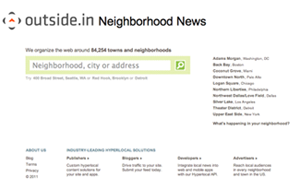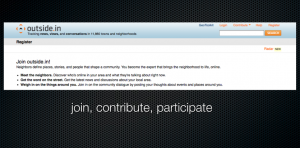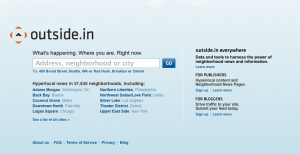outside.in
As I mentioned in the introduction, Yi-Fu Tuan spoke of place as growing out of interaction and experiences with spaces. “Getting to know” space occurs through activity in it—either direct experience or the communicated experiences of others. The sites I explore in this webtext provide both ways to “get to know” places and the people connected to them in ways which help shape collective identity as users read and contribute content to the sites. Let’s take a look at how some of this works on the social, hyperlocal news and information site outside.in.
According to co-creator Steven B. Johnson (2006), outside.in was “an attempt to collectively build the geographic Web, neighborhood by neighborhood” (n.p.). Johnson explained that the purpose of outside.in was to unite the various voices emerging from hyperlocal bloggers, review sites, city government sites, and traditional media while grounding the information geographically.
Outside.in’s default main page allows you to choose from a number of geographic locations either from a list, map, or by typing in your city or adress. Localized information comes up once users choose their location. The information is culled from news reports as well as blogs. The "for publishers" and "for bloggers" links on the main page encourage users to submit already published content about issues related to places in their geographic areas. With this feature, users can submit content directly from their blogs or news sources to outside.in.

Outside.in's main page
Since its conception in 2006, outside.in has changed drastically both in design and actual site content. I discuss some of these changes more specifically as I discuss relevance and layers of zoom, but I want to address the changes here because I spent a great deal of time exploring and theorizing outside.in as a site of hyperlocal content and was surprised to watch the site change so significantly since my initial research began.
When outside.in first came to my attention in November 2006, I was excited by the user-generated hyperlocal content. At the time, the site encouraged participation among users. To begin, users had to become a “neighbor” by joining the site. On the registration page users were met with the following message: “Meet the neighbors. Get the word on the street. Weigh in on the things around you.” At the time, the site depended on user involvement and a user's commitment to the hyperlocal. The tag line right before the registration forms read, “Neighbors define places, stories, and people that shape a community. You become the expert that brings the neighborhood to life, online.” Those statements encapsulated outside.in’s approach to “tracking news, views and conversations.” If users did not blog but still wanted to contribute to the community dialogue, they could participate on discussion boards, respond to threads, and geotag their location as well as other people's posts. None of these options is currently available and users no longer register on the site in order to view content. Additionally, there are advertisements on the site which did not exist in previous versions of outside.in (2006-09). The site has moved from instant user-generated content to aggregating previously published stories. For example, the language from the previous registration page in 2008: “You become the expert that brings the neighborhood to life, online” has been revised on the 2011 the FAQ page to this: “Hyperlocal content gives you the news and information for the area right around where you are, like the block around your office or the neighborhood where you live.” As I mention elsewhere in this webtext, this shift becomes a significant shift in metaphor from conversation to collection, and even though users can filter content, they remain passive receivers of information.

Registration page from outside.in 2008

Outside.in home page from February, 2010


June